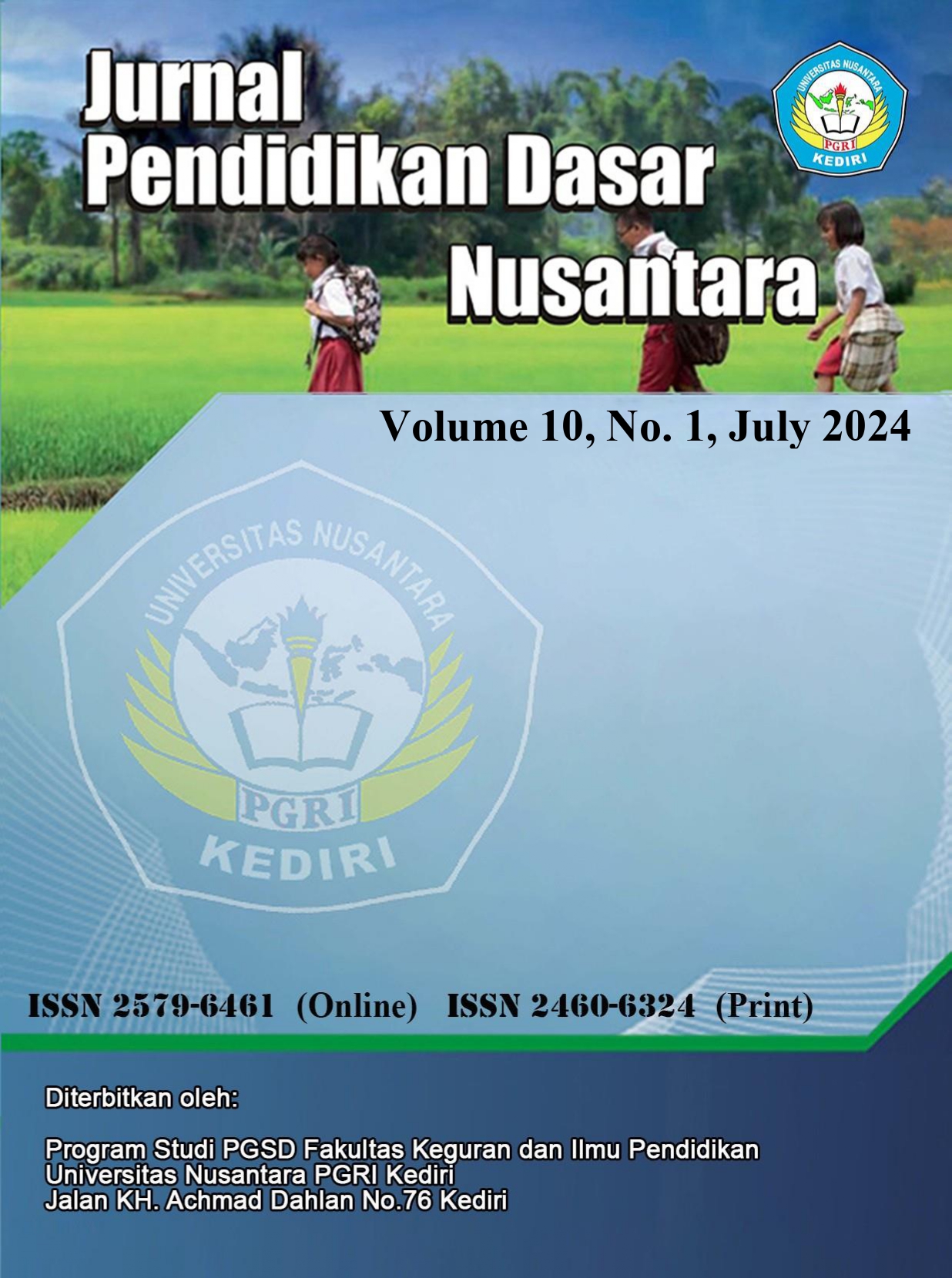Development of fun flipbook activity to improve class IV numeracy skills in elementary school
DOI:
https://doi.org/10.29407/jpdn.v10i1.22456Keywords:
fun flipbook activity ,numerasi, sekolah dasarAbstract
The purpose of this study was to determine the validity of the development of fun flipbook activity media in improving the numeracy skills of fourth grade students, to determine the implementation of fun flipbook activity media in improving the numeracy skills of fourth grade students, and to test the effectiveness of fun flipbook activity media in improving the numeracy skills of fourth grade students. The method and type of research used in this study were RnD with the ADDIE development model. The instruments used in this study included questionnaires, observation sheets and tests. This study was conducted at SDN 2 Kendalrejo with research subjects of 38 fourth grade students with low, medium and high abilities. From the study it was known (1) the level of validity of fun flipbook activity, from expert validation showed a percentage achievement of 91.5% with a high category or with very valid criteria and feasible to use, (2) the level of implementation based on the observation sheet, implemented reached a percentage of 95.5% with a very high category (3) the level of effectiveness of fun flipbook activity reached a percentage of 94.72% with a high category and feasible to use. Based on the data above, it shows that the fun flipbook activity developed is stated to be very valid, has high implementation and is effective for use in learning. Based on the data above, it shows that the fun flipbook activity media developed is stated to be very valid, has high implementation and is effective for use in learning.
Downloads
References
Achdiyat, M., & Utomo, R. (2017). Kecerdasan Visual-Spasial, Kemampuan Numerik, dan Prestasi Belajar Matematika. Formatif: Jurnal Ilmiah Pendidikan MIPA, 7(3), 234–245. https://doi.org/10.30998/formatif.v7i3.2234
Borg, W. R., & Gall, M. D. (2003). Educational Research, An Introduction (4th ed.). New York: Longman Inc.
Haerudin, H. (2018). Pengaruh Literasinumerasi Terhadap Perubahan Karakter Siswa. Prosiding Sesiomadika, 1(1), 401–409. Retrieved from https://journal.unsika. ac.id/index.php/sesiomadika/article/view/2123
Khanifatul. (2013). Pembelajaran Inovatif. Yogyakarta: Ar-Ruzz Media.
Letwinsky, K. M. (2017). Examining the Relationship between Secondary Mathematics Teachers’ Self-Efficacy, Attitudes, and Use of Technology to Support Communication and Mathematics Literacy. International Journal of Research in Education and Science, 3(1), 56–66.
Ojose, B. (2011). Mathematics Literacy: Are We Able To Put The Mathematics We Learn Into Everyday Use. Journal of Mathematics Education, 4(1), 89–100. Retrieved from https://www.researchgate.net/publication/228874128_Mathema tics_Literacy
Oktaviyani, H., & Karlimah, K. (2019). Peningkatan Pemahaman Konsep Operasi Hitung Penjumlahan Bilangan Cacah pada Siswa SD Menggunakan Media Pop Up Book. PEDADIDAKTIKA: Jurnal Ilmiah Pendidikan Guru Sekolah Dasar, 6(1), 203–210. https://doi.org/10.17509/pedadidaktika.v6i1.13180
Putri, A. D. A., & Sumardi, S. (2022). Pengembangan Bahan Ajar Digital Flipbook untuk Siswa SD. PEDADIDAKTIKA: Jurnal Ilmiah Pendidikan Guru Sekolah Dasar, 9(1), 173–186. https://doi.org/10.17509/pedadidaktika.v9i1.53130
Rusnilawati, R., & Gustiana, E. (2017). Pengembangan Bahan Ajar Elektronik (BAE) Berbantuan Flipbook Berbasis Keterampilan Pemecahan Masalah Dengan Pendekatan CTL Pada Pembelajaran Matematika Kelas V Sekolah Dasar. Profesi Pendidikan Dasar, 4(2), 190–201. Retrieved from https://journals.ums.ac.id/ index.php/ppd/article/view/5450
Sari, B. K. (2016). Desain Pembelajaran Model ADDIE dan Implementasinya Dengan Teknik Jigsaw. Sidoarjo: Universitas Muhammadiyah Sidoarjo.
Sari, W. N., & Ahmad, M. (2021). Pengembangan Media Pembelajaran Flipbook Digital di Sekolah Dasar. Edukatif: Jurnal Ilmu Pendidikan, 3(5), 2819–2826. Retrieved from https://www.edukatif.org/index.php/edukatif/article/view/1012
Sugiyono. (2015). Metode Penelitian Kualitatif Kuantitatif dan R&D. Bandung: Alfabeta.
Wati, H. W., & Susilawati, S. A. (2019). Pengembangan Media Pembelajaran Video Animasi Berbasis Adobe After Effect dalam Materi Banjir Siswa Kelas VII SMP Negeri 1 Weru Kabupaten Sukoharjo Universitas Muhammadiyah Surakarta. Surakarta:
Wiguna, F. A., Wenda, D. D. N., & Selan, D. A. (2024). Development of website-based teaching materials on the solar system for class V elementary school students. JURNAL PENDIDIKAN DASAR NUSANTARA, 9(2), 229-249. https://doi.org/10.29407/jpdn.v9i2.21834
Downloads
Published
Issue
Section
License
Authors who publish with this journal agree to the following terms:
- Copyright on any article is retained by the author(s).
- The author grants the journal, the right of first publication with the work simultaneously licensed under a Creative Commons Attribution License that allows others to share the work with an acknowledgment of the work’s authorship and initial publication in this journal.
- Authors are able to enter into separate, additional contractual arrangements for the non-exclusive distribution of the journal’s published version of the work (e.g., post it to an institutional repository or publish it in a book), with an acknowledgment of its initial publication in this journal.
- Authors are permitted and encouraged to post their work online (e.g., in institutional repositories or on their website) prior to and during the submission process, as it can lead to productive exchanges, as well as earlier and greater citation of published work.
- The article and any associated published material is distributed under the Creative Commons Attribution-ShareAlike 4.0 International License

































